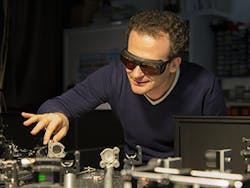New Research Injects Optimism into Quantum Computers
Quantum bits are the basic logic elements of quantum computers, as they correspond to the binary bits processed and stored by transistors in modern computer chips. Now, researchers at the Technical University of Munich (TUM) have taken the latest step toward incorporating quantum devices into computer technology, inventing semiconductor nanostructures that process information using quantum bits.
The invention of the nanostructures, however, was not the most significant aspect of the research. Of greater importance, the researchers said, was the ability to preserve the quantum bits contained within the nanostructures. Making certain that quantum bits, also known as qubits, remain intact while being stored has long been one of the major obstacles to making reliable quantum computers.
A team of physicists headed by Alexander Bechtold and Jonathan Finley at TUM’s Walter Schottky Institute created the nanostructures by evaporating indium gallium-arsenide (GaA) onto GaA substrates. The different lattice spacing of the two semiconductor materials creates strain at the interface between the crystal grids, producing what are known as quantum dots.
These quantum dots are extremely small lumps of semiconductor material that contain qubits and loosely correspond to electronic transistors. When the quantum dots are cooled down to liquid helium and excited by optical pulses, a single electron can be trapped in each dot. The electron’s spin serves as the information carrier, where “spin up” or “spin down” correspond to the standard logical information units 0 and 1. Laser pulses can read and alter the states optically from outside nanostructure.
Because they operate in a quantum-mechanical manner, however, the qubits can exist simultaneously as both 1 and 0, or some point in between. Being able to perform multiple operations at once could make quantum computers millions of times more powerful than modern supercomputers. They are thought to be ideal processors for breaking data encryption codes or searching large databases.
In spite of its potential speed benefits, there exist mechanisms through which the quantum data can be inadvertently lost. The strain between the semiconductor materials can generate tiny electric fields that result in “uncontrolled fluctuations in the nuclear spins” and alter the information, Bechtold says. It was also observed that electron spins are influenced by the spin of surrounding atomic nuclei.
The research, which was published in the journal Nature Physics and supported in part by the Los Alamos National Laboratory in New Mexico, introduced a method to reverse this quantum amnesia. “Both loss channels can be switched off when a magnetic field of around 1.5 tesla is applied,” says Bechtold. “This corresponds to the magnetic field strength of a strong permanent magnet. It stabilizes nuclear spins and the encoded information remains intact.”
Quantum dots are one of several competing technologies trying to at least coexist with electronic transistors in logic gates and computer processors. Optical computers, for instance, imprint data onto light waves and process information as it travels through silicon chips. All-optical devices can operate with extremely fast switching speeds and high energy efficiency because they exhibit lower heat loss, better signal-to-noise ratios, and reduced susceptibility to interference.
The TUM research team is optimistic about the future of their quantum computers because they were built from common semiconductor materials compatible with standard manufacturing processes—another major stumbling block to building a working quantum computer. The quantum dots can even be equipped with electrical contacts, allowing them to be controlled not only with lasers but also using pulses of electricity.
“Overall, the system is extremely promising,” says Finley. “The semiconductor quantum dots have the advantage that they harmonize perfectly with existing computer technology since they are made with similar semiconductor material.”
About the Author
James Morra
Senior Editor
James Morra is the senior editor for Electronic Design, covering the semiconductor industry and new technology trends, with a focus on power electronics and power management. He also reports on the business behind electrical engineering, including the electronics supply chain. He joined Electronic Design in 2015 and is based in Chicago, Illinois.


